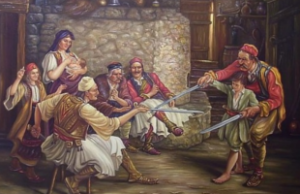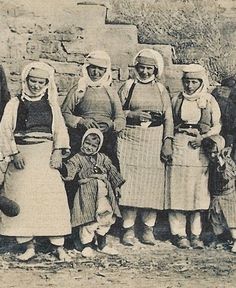Ancient Albania
 The people of Albania learned to use bronze about 2,100 BC. Then about 1,000 BC they learned to use iron. The iron age people of Albania are called the Illyrians. The Illyrians eventually came into conflict with Rome and the Romans conquered them in 167 BC.
The people of Albania learned to use bronze about 2,100 BC. Then about 1,000 BC they learned to use iron. The iron age people of Albania are called the Illyrians. The Illyrians eventually came into conflict with Rome and the Romans conquered them in 167 BC.
Under Roman rule Albania prospered. The Romans built roads in the area and towns like Elbasani grew up. However in 395 the Roman Empire split into two parts, East and West. Albania became part of the Eastern Empire, which is known to us as the Byzantine Empire.
During the 4th, 5th and 6th centuries Germanic peoples invaded Albania several times but they always withdrew. Between the invasions life went on as normal.
Yet because of its position on the edge of the Byzantine Empire Albania was weakly defended. In the 10th century the Bulgarians conquered large parts of Albania. However the Byzantines recovered their territory in the early 11th century when they were led by emperor Basil II.
Albania in the Middle Ages
 However in the 11th century the Normans captured Sicily and southern Italy and they turned their attention to Albania. They landed on the coast in 1081 and they captured Durresi but the Byzantines took it back in 1083 with help from Venice.
However in the 11th century the Normans captured Sicily and southern Italy and they turned their attention to Albania. They landed on the coast in 1081 and they captured Durresi but the Byzantines took it back in 1083 with help from Venice.
In 1204 the Crusaders captured Constantinople. For a time Albania was freed from Byzantine control and it was up for grabs. There followed a period of warfare with different powers fighting to control of Albania. Venice first seized central and southern Albania but they only directly ruled the main ports. After 1210 a Greek Vassal called Michael Commenus ruled the hinterland. However in 1215 Michael turned on the Venetians and he formed the despotate of Epirus.
Then in the late 13th century the Byzantines struggled with the kingdom of southern Italy and Sicily for control of Albania. The Byzantines eventually drove the Italians out but in the 14th century Albania fell to the Serbs.
The Serbian king Stefan Dusan first invaded Albania in 1343. However after his death in 1355 the Serbs lost control of Albania and the feudal lords fought among themselves for control. However there was a new threat to Albania - the Ottoman Turks.
The Turks occupied southern and central Albania in the years 1415-1423. However in 1443 a rebellion broke out. It was led by George Kastrioti (1403-1468). Under him and his son the Albanians in the north continued to resist the Turks until 1479.
Under Turkish rule some Albanians converted to Islam although Christians were allowed to practice their religion. Generally Turkish rule brought stability to Albania. However in the late 19th century a strong independence movement grew up in Albania.
Albania in the 20th century
The nationalist movement promoted Albanian language and culture. Then in 1912 war broke out between the Turks and the Balkan League (Montenegro, Greece, Serbia and Bulgaria). By 1912 the Turkish Empire was in steep decline and Albanians were afraid their country would be divided up between members of the Balkan League. To prevent that happening Albanian leaders met in Vlora and on 28 November 1912 they declared independence.
On 20 December 1912 the European great powers (Britain, France, Germany, Austria and Russia recognised Albanian independence. In 1913 they appointed a commission to demarcate Albania's borders. However they refused to recognise the provisional government in Albania. Instead they made a German prince, William of Wied king of Albania. William arrived in Albania in March 1914. However he fled after only six months in September 1914. Albania then split into regions without any central government.
However in 1918 the Albanians formed a provisional government. Elections were held and a parliament sat in Tirana in 1920. The Albanian Interior Minister was Ahmet Zogu (1895-1961). In December 1922 he became Albanian premier. However Zogu lost the election in January 1924 and he fled abroad in June 1924. Yet in December 1924 with Yugoslav help he marched on Tirana and overthrew the government. Zogu quickly made himself dictator. In 1928 he made himself King Zog of Albania.
 However Italian influence increased in Albania under Zog's rule. Finally on 7 April 1939
However Italian influence increased in Albania under Zog's rule. Finally on 7 April 1939
Mussolini, the Italian dictator invaded Albania. Zog fled abroad.
Mussolini installed a puppet government and after Germany conquered Yugoslavia and Greece in 1941 some their territory was given to Albania. Yet in November 1941 a Communist Party was formed with Enver Hoxha (1908-1985) as its secretary. From the summer of 1942 the Communists fought the Italians but when Italy surrendered in 1943 the Germans stepped in and occupied Albania. Yet the Communists formed a provisional government in May 1944. In October 1944 the Germans began to withdraw from Albania. Finally on 28 November 1944 the Communists entered Tirana. They then imposed a totalitarian regime in Albania.
The Communists began to nationalise industry in Albania and at first relations with Yugoslavia were friendly. However in 1948 Yugoslavia isolated itself from the Soviet Union and the other Eastern European Communist countries. Albania promptly ended economic agreements with Yugoslavia and in 1950 they broke off diplomatic relations (they were restored in 1953).
Then in the late 1950s relations between the Soviet Union and China grew worse. Albania sided with China and in the late 1950s the Chinese increased their economic aid to Albania. Finally in 1961 Albania broke off diplomatic relations with the Soviet Union.
After Mao died in 1976 relations between Albania and China cooled and ordinary people were completely isolated from the rest of the world. Enver Hoxha died in 1985 but the tyrannical regime in Albania continued.
Meanwhile Enver Hoxha was, like all Marxists an atheist. In 1967 he declared that Albania was the atheistic state in the world. Hoxha did all he could to eradicate religion from Albania. All religious buildings were closed and all worship was banned.
In 1990 the Albanian leader Ramiz Alia introduced some minor reforms. However in December 1990 student demonstrations forced the government to allow other political parties to form in Albania. Elections were held on 31 March 1991. The Communists won but a general strike in June forced them to resign. A coalition then ruled Albania until new elections were held in March 1992 and the Communist Party was forced to reinvented itself as the Socialist Party.
Meanwhile religious freedom was introduced in Albania in 1990. Today the majority of Albanians are Muslims. Significant minorities are Orthodox or Catholic.
In 1995 and 1996 pyramid investment schemes sprang up in Albania but at the end of 1996 they began to collapse. The result was unrest in Albania which forced the government to hold new elections in June 1997.
Albania in the 21st Century
Gradually stability returned to Albania. However since 1998 the Albanian economy has grown although Albania remains a poor country. Today the government is trying to improve infrastructure in Albania. Meanwhile in 2009 Albania joined NATO. Today Albania is hoping to join the EU. Today the population of Albania is 2.9 million.
 |
- Albania -
|  |
|||
Information about Albania: Albania officially the Republic of Albania, is a country in Southeastern Europe. Albania lies in the southwestern portion of the Balkan Peninsula bordered by Montenegro to the northwest, Kosovo to the northeast, the Republic of Macedonia to the east, and Greece to the south and southeast. The capital is Tirana with a population of approx 895000 (2020) Read More...











